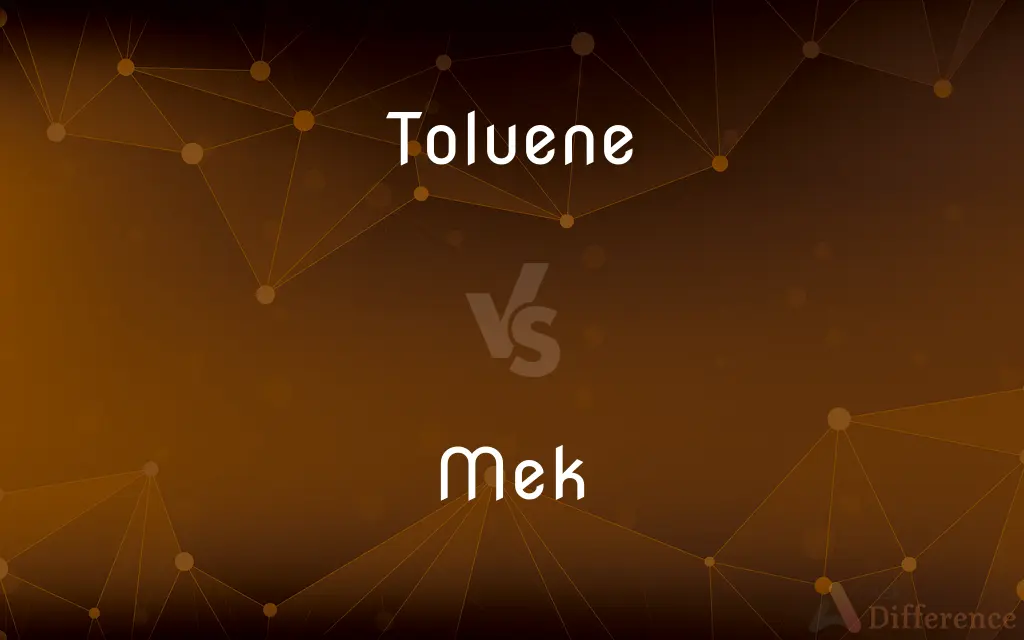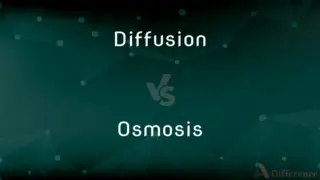Toluene vs. Mek — What's the Difference?
By Fiza Rafique & Urooj Arif — Updated on April 20, 2024
Toluene is an aromatic hydrocarbon used primarily as a solvent and in chemical synthesis, while MEK (methyl ethyl ketone) is a ketone used for similar purposes but differs in chemical structure and volatility.

Difference Between Toluene and Mek
Table of Contents
ADVERTISEMENT
Key Differences
Toluene is chemically a benzene ring substituted with a methyl group, known for its use in manufacturing paints, chemicals, and pharmaceuticals. While, MEK is a simpler compound with a ketone group, used extensively in surface coatings and adhesives.
Toluene has a sweet, pungent smell and is less polar than MEK. On the other hand, MEK is more polar and has a sharp, acrid odor, influencing its dissolving abilities and applications.
In terms of environmental impact and safety, toluene is less favorable due to its higher toxicity and potential to cause neurological damage. Whereas, MEK is considered more hazardous in terms of flammability but is generally less toxic neurologically.
Toluene is often preferred in applications requiring slower evaporation rates, which is beneficial for certain types of paint and coatings. In contrast, MEK evaporates more quickly, making it ideal for processes that require fast drying.
Both toluene and MEK are used as cleaning agents in industrial settings, but toluene is better suited for removing greasy residues, while MEK excels at removing resins and adhesives due to its stronger solvency.
ADVERTISEMENT
Comparison Chart
Chemical Structure
Benzene ring with a methyl group
Ketone, simpler structure
Common Uses
Paints, adhesives, chemical synthesis
Surface coatings, adhesives
Odor
Sweet, pungent
Sharp, acrid
Evaporation Rate
Slower
Faster
Environmental and Safety Concerns
More toxic, neurologically harmful
More flammable, less neurotoxic
Compare with Definitions
Toluene
Aromatic hydrocarbon used as an industrial solvent.
Toluene is often used to dissolve paints.
Mek
Used in the manufacture of plastics and textiles.
MEK is a key solvent in the production of PVC.
Toluene
Used in the manufacture of TNT.
Toluene is nitrated to produce trinitrotoluene, a type of explosive.
Mek
Effective in removing resins and adhesives.
MEK can clean surfaces before painting or coating.
Toluene
Solvent in printing and leather tanning industries.
Toluene dissolves inks effectively in printing processes.
Mek
Solvent used in the production of surface coatings.
MEK is essential for formulating high-performance lacquers.
Toluene
Common ingredient in the production of benzene.
Toluene is converted into benzene through hydrodealkylation.
Mek
Used in chemical synthesis.
MEK is a starter material for many synthetic rubber products.
Toluene
Component in aviation gasoline.
Toluene enhances the octane rating of aviation fuels.
Mek
Common in the printing industry.
MEK dissolves printing inks quickly for efficient cleaning.
Toluene
Toluene (), also known as toluol (), is an aromatic hydrocarbon. It is a colorless, water-insoluble liquid with the smell associated with paint thinners.
Mek
A terrorist organization formed in the 1960s by children of Iranian merchants; sought to counter the Shah of Iran's pro-Western policies of modernization and anti-communism; following a philosophy that mixes Marxism and Islam it now attacks the Islamic fundamentalists who deposed the Shah
Toluene
A colorless flammable aromatic liquid, C7H8, obtained from coal tar or petroleum and used in aviation fuel and other high-octane fuels, in dyestuffs, explosives, and as a solvent for gums and lacquers. Also called methylbenzene.
Toluene
(organic compound) A colourless, inflammable liquid hydrocarbon, methylbenzene, CH3.C6H5, used as a solvent, in high-octane fuels and in the production of many chemical compounds.
Toluene
A hydrocarbon, C6H5.CH3, of the aromatic series, homologous with benzene, and obtained as a light mobile colorless liquid, by distilling tolu balsam, coal tar, etc.; - called also methyl benzene, phenyl methane, etc.
Toluene
A colorless flammable liquid obtained from petroleum or coal tar; used as a solvent for gums and lacquers and in high-octane fuels
Common Curiosities
How do toluene and MEK impact the environment?
Both can contribute to air and water pollution if not handled properly, with toluene being particularly hazardous due to its toxicity.
What safety precautions are necessary when handling toluene and MEK?
Proper ventilation, protective clothing, and adherence to safety guidelines are essential due to their toxicity and flammability.
Why is toluene considered more neurologically toxic than MEK?
Toluene's chemical structure allows it to affect the central nervous system more profoundly than MEK.
How do the solvent properties of toluene and MEK differ?
Toluene is effective at dissolving non-polar substances due to its aromatic nature, whereas MEK, being more polar, is better at dissolving polar substances like certain plastics and resins.
What is the primary use of toluene and MEK?
Toluene is primarily used as a solvent in paints and chemical synthesis, while MEK is used in surface coatings and adhesives.
How do toluene and MEK react with other chemicals?
Toluene and MEK can react with strong oxidizers, acids, and bases, potentially leading to hazardous reactions or breakdown products.
Can toluene and MEK be used interchangeably?
While both are solvents, their different properties often dictate specific uses, making them not always interchangeable.
Can toluene and MEK be found in household products?
Yes, both chemicals can be found in various household products including paints, varnishes, adhesives, and cleaning products.
What alternatives exist for toluene and MEK in industrial applications?
Alternatives include less toxic solvents like acetone, ethanol, or iso-propanol, which can sometimes be used depending on the application's specific requirements.
Is MEK more environmentally friendly than toluene?
Neither chemical is particularly environmentally friendly; both are volatile organic compounds that contribute to air pollution, though toluene is generally considered more toxic.
Are there any health risks associated with prolonged exposure to MEK?
Yes, prolonged exposure to MEK can lead to adverse health effects, including irritation of the skin, eyes, and respiratory tract, and potential long-term organ damage.
What is the boiling point of toluene compared to MEK?
Toluene has a higher boiling point (around 111°C) compared to MEK, which boils at about 80°C.
What are the regulatory concerns with using toluene and MEK?
Both chemicals are subject to regulatory scrutiny due to their health, safety, and environmental risks, requiring proper handling, labeling, and disposal under laws like those enforced by OSHA and the EPA in the U.S.
How are spills of toluene and MEK handled?
Spills of both chemicals require immediate containment and cleanup to prevent environmental contamination and health hazards. Specific protocols depend on the volume and location of the spill.
Is it safe to mix toluene and MEK?
Mixing chemicals should always be done with caution and awareness of potential reactions. While toluene and MEK can be mixed, it's important to understand the purpose and any safety implications.
Share Your Discovery

Previous Comparison
Diffusion vs. Osmosis
Next Comparison
Packing vs. PackagingAuthor Spotlight
Written by
Fiza RafiqueFiza Rafique is a skilled content writer at AskDifference.com, where she meticulously refines and enhances written pieces. Drawing from her vast editorial expertise, Fiza ensures clarity, accuracy, and precision in every article. Passionate about language, she continually seeks to elevate the quality of content for readers worldwide.
Co-written by
Urooj ArifUrooj is a skilled content writer at Ask Difference, known for her exceptional ability to simplify complex topics into engaging and informative content. With a passion for research and a flair for clear, concise writing, she consistently delivers articles that resonate with our diverse audience.














































